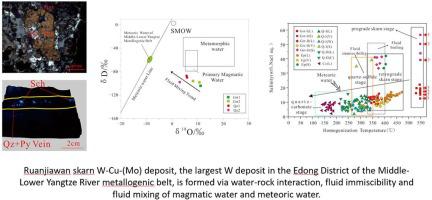Ore Geology Reviews ( IF 3.2 ) Pub Date : 2021-08-27 , DOI: 10.1016/j.oregeorev.2021.104428 Da-Long Hu 1 , Shao-Yong Jiang 1 , Deng-Fei Duan 1, 2 , Suo-Fei Xiong 1

|
Ruanjiawan W-Cu-(Mo) deposit, located in the Edong District of the Middle-Lower Yangtze River metallogenic belt, is one of the largest W deposits (40348 tons WO3 at an average grade of 0.32 wt%) in this ore district. The orebodies mainly occur in the contact zone between the granitoid and Ordovician carbonate strata. A detailed field geology and petrographic observation indicates four stages of ore formation: (1) prograde skarn stage, (2) retrograde skarn stage, (3) quartz-sulfide stage, and (4) quartz-carbonate stage. The δ18O values of the ore fluids vary from 3.0‰ to 11.2‰, and the δD values vary from −88‰ to −105‰, suggesting a dominant magmatic water origin, with a small amount of meteoric water mixing during the late stages. The δ13C values of fluid inclusions vary from −15.0‰ to −7.1‰, also indicating a major magmatic carbon source but with some mixing of organic carbon component in the sedimentary strata that probably leached by circulated meteoric water. The sulfides show a large δ34S variation from −4.8‰ to +16.3‰, and the sulfur may have two different sources, with a majority magmatic source (with δ34S around 0), and some marine sulphate source (with high positive δ34S value) in sedimentary strata in the region leached by meteoric water. In the prograde skarn stage, garnet shows a fluid inclusion homogenization temperature above 517 °C. The estimated salinity of the vapour-liquid two-phase inclusions ranges from 15.7 to 21.4 wt% NaCl equiv., and the salinity of the daughter mineral-bearing inclusions ranges from 39.8 to 57.1 wt% NaCl equiv. In the retrograde skarn stage, the fluid inclusions in epidote show a homogenization temperature of 385 °C to 463 °C, and the salinity estimated from the vapour-liquid two-phase inclusions ranges from 9.7 to 16.4 wt% NaCl equiv. The fluid inclusions in coarse-grained garnet from the retrograde skarn stage show similar homogenization temperature of 339 °C to 398 °C, and similar salinity of vapour-liquid two-phase inclusions of 7.4 to 15.3 wt% NaCl equiv., however, the salinity estimated from the daughter mineral-bearing inclusions ranges from 35.2 to 42.0 wt% NaCl equiv. In the quartz-sulfide stage, fluid inclusions in quartz show a homogenization temperature of 274 °C to 344 °C. The salinity varies from 6.5 to 14.0 wt% NaCl equiv. for the vapour-liquid two-phase inclusions, from 5.1 to 8.0 wt% NaCl equiv. for the CO2-bearing three phase inclusions, and from 35.3 to 39.8 wt% NaCl equiv. for the daughter-mineral-bearing inclusions. In the quartz-carbonate stage, the fluid inclusions have homogenization temperatures from 137 °C to 261 °C, and the salinity for the vapour-liquid two-phase inclusions shows a range from 3.9 to 1.0 wt% NaCl equiv. Fluid boiling and water-rock reaction in the retrograde skarn stage lead to the first precipitation of scheelite. The precipitation of scheelite, chalcopyrite and molybdenite in the quartz-sulfide stage was mostly triggered by the mixing of meteoric water and magmatic fluids, and fluid immiscibility also plays an important role. According to petrographic evidence and all available geological and geochemical data, we conclude that the Ruanjiawan deposit is an oxidized skarn-type W-Cu-(Mo) deposit.
中文翻译:

长江中下游成矿带鄂东区阮家湾钨铜(钼)矿床流体成因与演化:流体包裹体和高碳同位素约束
阮家湾钨铜(钼)矿床位于长江中下游成矿带鄂东区,是该矿区最大的钨矿床之一(40348吨WO 3,平均品位0.32 wt%) . 矿体主要产于花岗岩与奥陶系碳酸盐岩地层的接触带。详细的野外地质和岩相观察表明成矿有四个阶段:(1) 顺行矽卡岩阶段,(2) 逆行矽卡岩阶段,(3) 石英-硫化物阶段,和 (4) 石英-碳酸盐阶段。矿液δ 18 O值3.0‰~11.2‰,δD值-88‰~-105‰,表明以岩浆水为主,后期有少量大气水混合. δ 13流体包裹体的 C 值从 -15.0‰ 到 -7.1‰ 不等,这也表明是一个主要的岩浆碳源,但在沉积地层中混合了一些有机碳成分,可能被循环的大气水浸出。硫化物的δ 34 S 变化很大,从-4.8‰ 到+16.3‰,硫可能有两种不同的来源,主要是岩浆源(δ 34 S 在 0 左右)和一些海相硫酸盐源(高正δ 34S值)在被大气水淋洗的地区的沉积地层中。在顺产矽卡岩阶段,石榴石显示流体包裹体均质温度高于 517 °C。气液两相包裹体的估计盐度范围为 15.7 至 21.4 wt% NaCl equiv.,含子矿物包裹体的盐度范围为 39.8 至 57.1 wt% NaCl 当量。在逆行矽卡岩阶段,绿帘石中流体包裹体的均一化温度为 385 ℃~463 ℃,气液两相包裹体估计盐度为 9.7 ~ 16.4 wt% NaCl equiv。逆行矽卡岩阶段粗粒石榴石中的流体包裹体表现出相似的均质温度为 339°C 至 398°C,气液两相包裹体的盐度相似,为 7.4 至 15.3 wt% NaCl 当量,然而,从含有子矿物的包裹体估计的盐度范围为 35.2 至 42.0 wt% NaCl 当量。在石英-硫化物阶段,石英中的流体包裹体表现出274℃~344℃的均质温度。盐度从 6.5 到 14.0 wt% NaCl 当量不等。对于气液两相包裹体,5.1 至 8.0 wt% NaCl 当量。对于 CO2 - 含三相夹杂物,以及 35.3 至 39.8 wt% NaCl 当量。对于含子矿物的包裹体。在石英-碳酸盐阶段,流体包裹体的均一化温度为 137°C 至 261°C,气液两相包裹体的盐度范围为 3.9 至 1.0 wt% NaCl 当量。逆行矽卡岩阶段的流体沸腾和水岩反应导致白钨矿首次沉淀。石英-硫化物阶段白钨矿、黄铜矿和辉钼矿的沉淀主要是由大气水和岩浆流体混合引发的,流体不混溶性也起着重要作用。根据岩相证据和所有可用的地质和地球化学资料,我们得出结论,阮家湾矿床是氧化矽卡岩型W-Cu-(Mo)矿床。











































 京公网安备 11010802027423号
京公网安备 11010802027423号